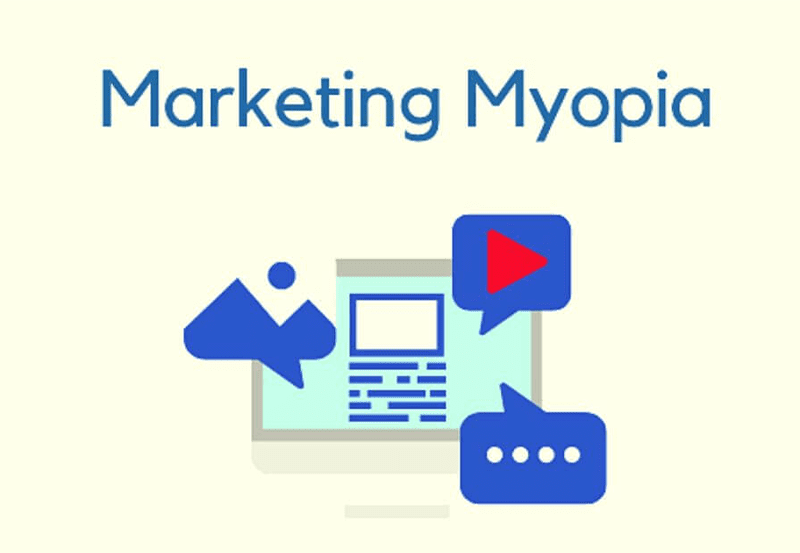Maintaining a competitive edge has become more critical in today’s rapidly evolving business landscape. One essential aspect of staying ahead of the competition is understanding and avoiding marketing myopia, a concept that can be the difference between the success or failure of a business. This brings us to Marketing Myopia and Why Should You Care? In this post, we will explore the concept of marketing myopia, why it’s crucial for businesses to care about it, and how to prevent it from impacting your organization’s long-term success. Let’s dive in!
Table of Contents
1: Defining Marketing Myopia
Marketing myopia, a term coined by Theodore Levitt in his 1960 Harvard Business Review article, refers to a short-sighted and narrow-minded approach to marketing, where businesses focus too much on their products and services instead of the customer’s needs and preferences. This tunnel vision, often referred to as Marketing Myopia and Why Should You Care, can lead organizations to overlook emerging trends, lose touch with their target audience, and ultimately fail to adapt to changes in the market. By understanding the implications of marketing myopia, businesses can take necessary precautions to avoid these pitfalls and ensure long-term success.
2: Examples of Marketing Myopia
Throughout history, numerous well-known companies have fallen victim to marketing myopia, leading to their downfall or significant loss of market share. Some of these examples include:

- Kodak: The once-dominant photography company should have anticipated the rise of digital photography, sticking to its traditional film-based products. This lack of foresight ultimately led to Kodak’s bankruptcy in 2012.
- Blockbuster: The video rental giant succumbed to marketing myopia by failing to recognize the shift in consumer preferences toward digital streaming services. Their reluctance to innovate and adapt to the changing market allowed competitors like Netflix to thrive, leaving Blockbuster to declare bankruptcy in 2010.
3: The Importance of Avoiding Marketing Myopia
Now that we understand what marketing myopia is and its potential consequences let’s discuss why businesses should care about this concept:
- Long-term success: By focusing on customer needs and preferences, organizations can develop products and services that cater to evolving market demands, ensuring long-term success and growth.
- Competitive advantage: Avoiding marketing myopia allows businesses to stay ahead of industry trends and adapt to changes in the market, providing them with a competitive edge over organizations that are slow to respond.
- Brand reputation: Companies that clearly understand their customers’ needs are more likely to build and maintain strong relationships with their target audience, resulting in a positive brand reputation and customer loyalty.
4: How to Prevent Marketing Myopia
To avoid the pitfalls of marketing myopia, businesses must take proactive steps to maintain a customer-centric approach and adapt to changing market conditions. In the context of Marketing Myopia and Why you should care, here are some strategies to help you prevent marketing myopia in your organization and ensure that you are always putting your customers’ needs first:

- Focus on customer needs: Instead of concentrating solely on your products and services, prioritize understanding and fulfilling your customers’ needs. This can be achieved through market research, customer feedback, and regular interaction with your target audience.
- Embrace innovation: Encourage a culture of innovation within your organization, as it allows you to stay ahead of emerging trends and adapt to the ever-changing market landscape. Invest in research and development, and be open to new ideas and technologies.
- Monitor industry trends: Stay informed about changes in your industry and watch for emerging trends that could impact your business. By being aware of the market dynamics, you can anticipate customer needs and preferences, allowing you to develop relevant products and services.
- Foster organizational agility: Create a flexible organizational structure that adapts quickly to changing market conditions. Encourage open communication and collaboration across departments, and empower employees to make decisions that are in your customers’ best interests.
- Diversify your offerings: Avoid becoming too reliant on a single product or service by diversifying your offerings. This not only helps to mitigate risks associated with market changes but also allows you to cater to a broader range of customer needs, ensuring long-term stability and growth.
- Continuous learning and improvement: Encourage a culture of constant learning and progress within your organization. Regularly review your marketing strategies and tactics, and refine them based on customer feedback and market developments. This will help you stay in tune with your audience’s needs and maintain a competitive edge.
Conclusion
In conclusion, marketing myopia can be detrimental to businesses, leading to a loss of market share, customer dissatisfaction, and, in some cases, bankruptcy. By understanding the concept of marketing myopia and grasping the importance of Marketing Myopia and Why Should You Care, organizations can take steps to prevent this short-sighted approach and stay ahead of the competition. Recognizing the potential consequences and implementing strategies to overcome marketing myopia will ultimately contribute to a more prosperous and sustainable business.
To avoid marketing myopia, businesses must focus on customer needs, embrace innovation, monitor industry trends, foster organizational agility, diversify their offerings, and continuously learn and improve. By adopting these strategies, companies can maintain a customer-centric approach, ensure long-term success, and build a strong brand reputation. So, as you move forward with your business endeavours, always remember to keep your customers’ needs and preferences at the forefront of your marketing strategy to steer clear of marketing myopia and its consequences.
If you’re interested in reading more informative blogs, Click here.




